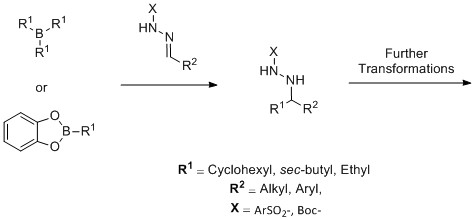Free-radical transformations involving organoboranes and hydrazones
Trialkylboranes and alkyl-catecholboranes (commercially available or prepared by hydroboration of olefins) represent a versatile source of alkyl radicals which can be used in different synthetic transformations.1 The nucleophilic character of the radicals generated makes possible their addition to suitable electrophilic traps.2 In this work we describe the addition of alkyl radicals to hydrazones which by turn can serve as a method for the functionalization of olefins. Additionally, we present insights about how the corresponding products can be further transformed into compounds of synthetic value.

[1] Cyril Ollivier, Philippe Renaud, Chem. Rev. 2001, 101, 3415−3434.
[2] Gregory K. Friestad, Tetrahedron, 2001, 57, 5461-5496.